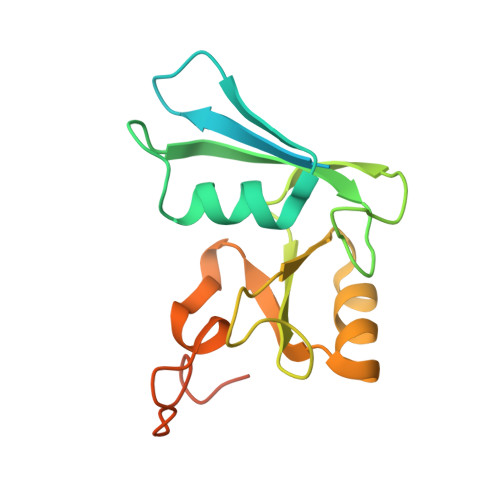Structural Studies of Apo Nosl, an Accessory Protein of the Nitrous Oxide Reductase System: Insights from Structural Homology with MerB, a Mercury Resistance Protein.
Taubner, L.M., McGuirl, M.A., Dooley, D.M., Copie, V.(2006) Biochemistry 45: 12240-12252
- PubMed: 17014077
- DOI: https://doi.org/10.1021/bi061089+
- Primary Citation of Related Structures:
2HPU, 2HQ3 - PubMed Abstract:
The formation of the unique catalytic tetranuclear copper cluster (Cu(Z)) of nitrous oxide reductase, N(2)OR, requires the coexpression of a multiprotein assembly apparatus encoded by the nosDFYL operon. NosL, one of the proteins encoded by this transcript, is a 20 kDa lipoprotein of the periplasm that has been shown to bind copper(I), although its function has yet to be detemined. Cu(I) EXAFS data collected on the holo protein demonstrated that features of the copper binding site are consistent with a role for this protein as a metallochaperone, a class of metal ion transporters involved in metal resistance, homeostasis, and metallocluster biosynthesis. To test this hypothesis and to gain insight into other potential functional roles for this protein in the N(2)OR system, the three-dimensional solution structure of apo NosL has been solved by solution NMR methods. The structure of apo NosL consists of two relatively independent homologous domains that adopt an unusual betabetaalphabeta topology. The fold of apo NosL displays structural homology to only one other protein, MerB, an organomercury lyase involved in bacterial mercury resistance (Di Lello et al. (2004) Biochemistry 43, 8322-32). The structural similarity between apo NosL and MerB, together with the absolute conservation of Met109 in all NosL sequences, indicates that this residue may be involved in copper ligation, and that the metal binding site is likely to be solvent-accessible and contiguous with a large binding cleft. The structural observations suggest that NosL is exceptionally adapted for a role in copper and/or sulfur delivery and possibly for metallochaperone function.
Organizational Affiliation:
Department of Chemistry and Biochemistry, Montana State University, Bozeman, Montana 59717, USA.













